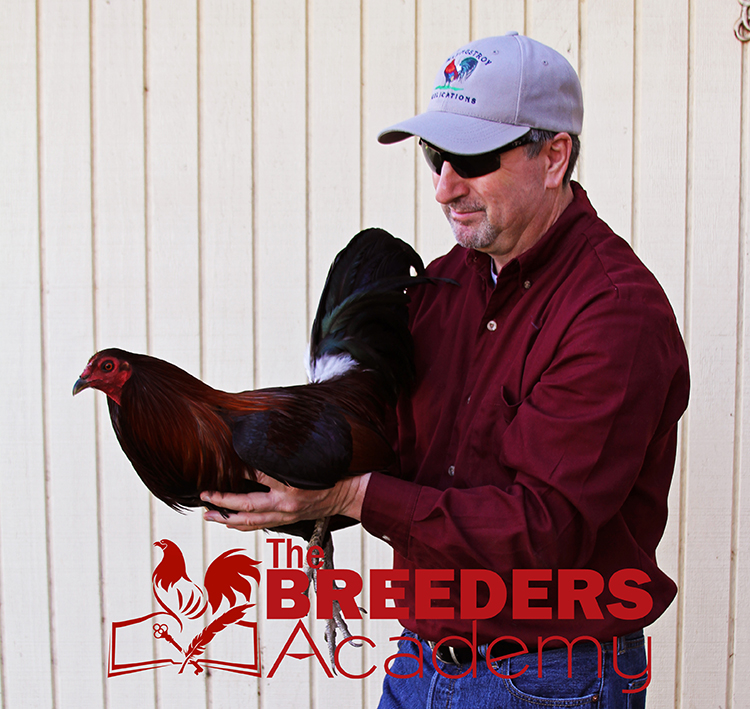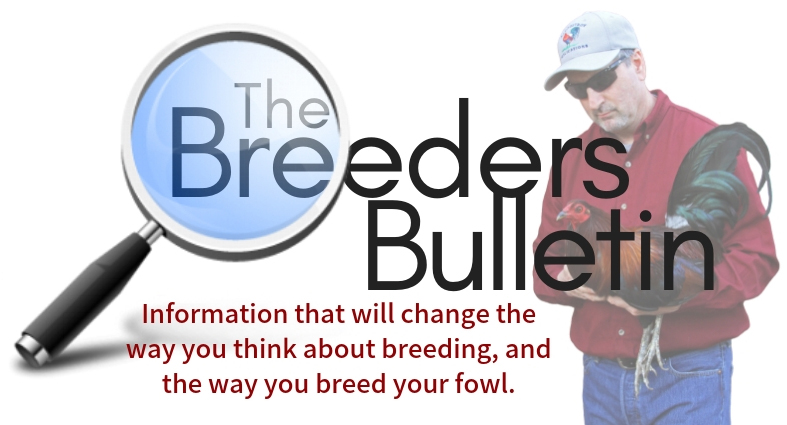by Understanding the effects of Dominant and Recessive Traits
By Kenny Troiano
 Gregor Mendel’s greatest achievement was his ability to interpret, from the information he attained from crossing plants, having dissimilar traits. He was able to demonstrate that certain characteristics, such as tallness, were dominant. A tall plant crossed with a short plant resulted in tall offspring. But if breeding continued, using the tall offspring, a mixture of tall and short, in the ratio of 3 to 1, appeared in the next generation.
Gregor Mendel’s greatest achievement was his ability to interpret, from the information he attained from crossing plants, having dissimilar traits. He was able to demonstrate that certain characteristics, such as tallness, were dominant. A tall plant crossed with a short plant resulted in tall offspring. But if breeding continued, using the tall offspring, a mixture of tall and short, in the ratio of 3 to 1, appeared in the next generation.
Now, let’s look at Gamefowl Breeding and Gamefowl Genetics. If we look at what Mendel learned from studying pea plants we can also see how this affects certain characteristics in chickens, such as pea-combs are dominant over single-combs. A pea-comb cock crossed with a single-combed hen will result in pea-combed offspring, but only in the first generation. But if breeding is continued, such as in the case of inbreeding or line-breeding, using the pea-comb offspring, bred back to their parents, this would give you, in the second generation, a mixture of pea-comb and single-combed offspring. Although the resulting offspring all came pea-combed, they now also carry the recessive trait for single-comb.
The pea-comb trait is dominant over the single-comb trait, and dominant traits always overpower recessive traits when they stand up to each other, as a result, the dominant trait will be expressed in the offspring. A recessive trait will be expressed in the offspring only when both the cock and hen carry the same recessive trait, even if the recessive trait is not expressed at the time of mating.
The more inbred a family is, the more you will see the recessive traits that are hidden within the family.
Another example of Dominant and Receive traits: American Games, much like other gamefowl breeds, have many traits that are either dominant or recessive, for instance, the color of their legs. Green legs are recessive to yellow legs, and yellow legs are recessive to white legs.
Another example is the color of plumage. American Games come in a variety of plumage colors, but are of two separate color classifications. They are of either a “Red” or “Silver” classification. This is a genetic definition that also takes into account the many variations that are in between. No matter the color of plumage, they are still of either the “Red” or of the “Silver” classification.
A typical Red variety is the Black Breasted-Red. A typical Silver variety is the Black Breasted-Silver Duckwing, or Grey, as we know them today. Red is recessive to Silver, and Silver is dominant over Red.
Sex-linkage, and dominant and recessive traits: If a Black Breasted-Red Cock, with two recessive genes for Red coloring is bred to a Black Breasted-Silver Duckwing Hen, with a dominant Silver gene, it might be thought that the dominant gene would come through, and make all the offspring Silver, and indeed it does, but for the stags only! They alone receive the dominant gene from their mother, and will appear as Silver/Greys. The pullets receive no gene from their mother, so the recessive Red gene, that came from their father will determine the pullets color, and because of this, they will hatch out as Red (Partridge) chicks.
Special note of interest: many breeders favor this breeding, because it helps to distinguish the partridge pullets from their Silver/Grey brothers at a younger age.
The Silver-Red combination only works when breeding a Red cock to a Silver Hen. When breeding a Silver Cock (that carries a dominant Silver gene) with a Black Breasted-Red Hen (that carries a recessive Red gene) the resulting offspring are all Silver/Grey.
A heterozygous Silver Cock (meaning a cock expressing the Grey plumage color, but also carries the Red gene) bred to a recessive Red Hen, will produce offspring having a mixture of Silver and Red.
As a gamefowl breeder, we can learn a lot through the scientific breeding of American Games. By understanding Dominant and Recessive Genes we apply this knowledge to our breeding programs.
Hope you enjoyed the article, and thanks again for reading.
Join us at the BREEDERS ACADEMY, and learn how to create a true strain, one that you can be proud of. I will help you to increase your knowledge of breeding, advance your skills as a breeder, and help you to improve the quality and performance of your fowl. I’m confident that if you follow my advice, your fowl will improve. So, check it out – https://americangamefowlbreedersacademy.com
Also, be sure to check out our new Podcast, called “Bred to Perfection” – a show for the serious breeder.
Make sure to sign up for our Breeders Bulletins (weekly newsletters)
Yours truly, Kenny Troiano
Author of the Gamefowl Breeders Manuals
Owner of the Breeders Academy Membership Website
And, Host of the Bred to Perfection Podcast
Visit us atwww.breedersacademy.com

